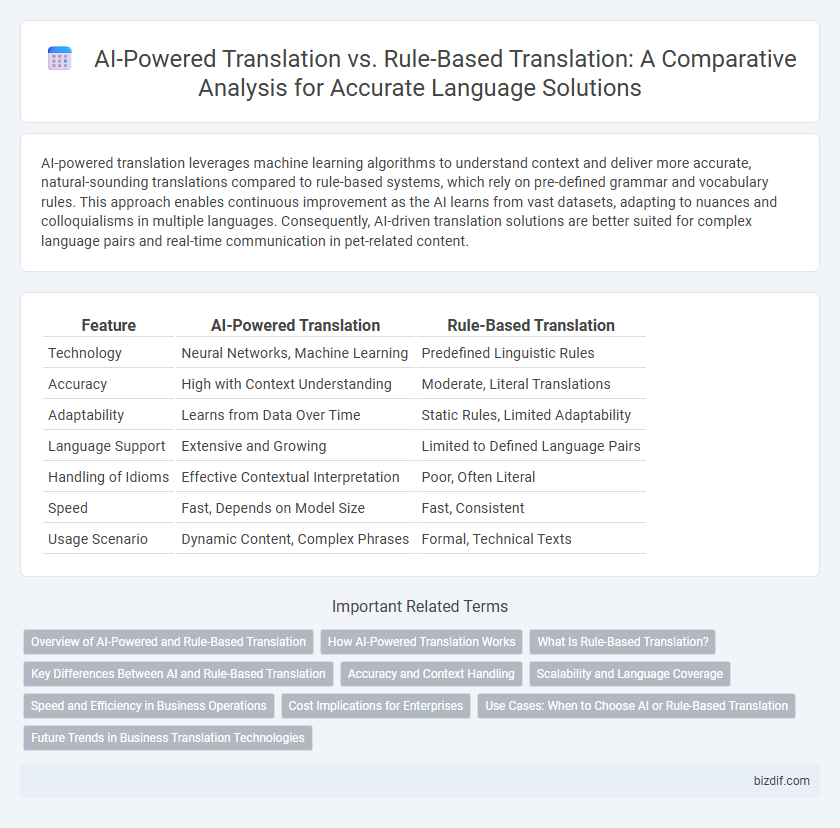AI-powered translation leverages machine learning algorithms to understand context and deliver more accurate, natural-sounding translations compared to rule-based systems, which rely on pre-defined grammar and vocabulary rules. This approach enables continuous improvement as the AI learns from vast datasets, adapting to nuances and colloquialisms in multiple languages. Consequently, AI-driven translation solutions are better suited for complex language pairs and real-time communication in pet-related content.
Table of Comparison
| Feature | AI-Powered Translation | Rule-Based Translation |
|---|---|---|
| Technology | Neural Networks, Machine Learning | Predefined Linguistic Rules |
| Accuracy | High with Context Understanding | Moderate, Literal Translations |
| Adaptability | Learns from Data Over Time | Static Rules, Limited Adaptability |
| Language Support | Extensive and Growing | Limited to Defined Language Pairs |
| Handling of Idioms | Effective Contextual Interpretation | Poor, Often Literal |
| Speed | Fast, Depends on Model Size | Fast, Consistent |
| Usage Scenario | Dynamic Content, Complex Phrases | Formal, Technical Texts |
Overview of AI-Powered and Rule-Based Translation
AI-powered translation utilizes neural networks and machine learning algorithms to deliver context-aware and highly accurate language conversions by continuously learning from vast datasets. Rule-based translation relies on predefined linguistic rules, grammar structures, and dictionaries, ensuring consistent output but often lacking adaptability and nuance in complex language scenarios. Combining AI's dynamic learning capabilities with rule-based precision enhances translation quality across diverse languages and domains.
How AI-Powered Translation Works
AI-powered translation utilizes neural networks and machine learning algorithms to analyze and interpret vast amounts of multilingual data, enabling more accurate and context-aware language conversion. These systems continuously improve through feedback loops and exposure to diverse sentence structures, idioms, and cultural nuances. The underlying technology processes input text by predicting the most probable translation based on patterns learned from extensive bilingual corpora, surpassing the static nature of rule-based translation methods.
What Is Rule-Based Translation?
Rule-based translation relies on a predefined set of linguistic rules and grammar structures to convert text from one language to another, ensuring consistent and predictable outputs. This approach utilizes extensive dictionaries and morphological analyzers to parse and reconstruct sentences based on syntactic and semantic rules. Despite its accuracy in handling formal and structured language, rule-based translation often struggles with idiomatic expressions and context nuances compared to AI-powered methods.
Key Differences Between AI and Rule-Based Translation
AI-powered translation leverages neural networks and machine learning algorithms to understand context and continuously improve accuracy through data exposure, while rule-based translation relies on predefined linguistic rules and bilingual dictionaries for direct word-to-word conversion. AI systems excel at handling ambiguous phrases, idiomatic expressions, and flexible sentence structures, whereas rule-based methods perform well in controlled, domain-specific translations with predictable grammar. The scalability and adaptability of AI-driven translation engines outpace rule-based models, which require extensive manual updates to maintain accuracy across languages.
Accuracy and Context Handling
AI-powered translation leverages neural networks and machine learning to achieve higher accuracy by understanding context, idiomatic expressions, and nuanced language use. Rule-based translation relies on predefined linguistic rules and dictionaries, often leading to rigid and less accurate outputs in complex or ambiguous contexts. Advanced AI models adapt over time, improving context handling and delivering more natural, precise translations across diverse languages and domains.
Scalability and Language Coverage
AI-powered translation systems leverage neural networks and vast datasets to scale efficiently across hundreds of languages, offering dynamic adaptability to linguistic nuances. Rule-based translation relies on predefined grammatical rules and dictionaries, limiting scalability and language coverage due to the manual effort required for each language pair. The scalability of AI models enables continuous improvement and expansion, surpassing the static, language-specific constraints of rule-based methods.
Speed and Efficiency in Business Operations
AI-powered translation leverages advanced neural networks to deliver rapid and contextually accurate translations, significantly accelerating business operations by reducing turnaround times. Rule-based translation relies on predefined linguistic rules, resulting in slower processing and limited scalability for diverse languages or complex content. Businesses benefit from AI-driven solutions through enhanced efficiency, improved consistency, and the ability to handle large volumes of multilingual content seamlessly.
Cost Implications for Enterprises
AI-powered translation significantly reduces long-term costs for enterprises by automating complex language processing tasks and minimizing the need for extensive human post-editing. Rule-based translation systems involve higher upfront investments in developing language rules and dictionaries but often incur ongoing expenses due to limited scalability and less accurate output. Enterprises seeking cost efficiency benefit from AI models that continuously learn and adapt, decreasing reliance on manual intervention and accelerating multilingual content delivery.
Use Cases: When to Choose AI or Rule-Based Translation
AI-powered translation excels in handling large volumes of diverse content with natural language nuances, making it ideal for customer support, social media, and marketing materials. Rule-based translation suits specialized fields such as legal, medical, or technical documents where precision and consistency with terminology are critical. Selecting AI or rule-based translation depends on the specific use case requirements for accuracy, speed, and context sensitivity.
Future Trends in Business Translation Technologies
AI-powered translation leverages neural networks and deep learning to deliver highly accurate and context-aware translations, surpassing the limitations of traditional rule-based systems that rely on pre-defined linguistic rules. Emerging technologies such as adaptive machine learning models enable real-time customization for specific industries, enhancing the precision and relevance of business translations. Future trends highlight the integration of AI-driven translation platforms with enterprise workflows, driving efficiency and supporting multilingual communication at a global scale.
AI-Powered Translation vs Rule-Based Translation Infographic

 bizdif.com
bizdif.com